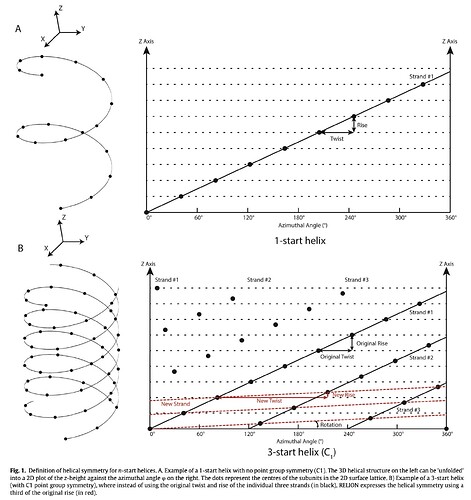Hi @orangeboomerang,
Chiming in a bit late, but I can clarify the difference between “n-start C1 helical symmetry”, and a “n-start Cn helical symmetry”. These are best described by Shaoda He and Sjors Scheres’ Helical reconstruction in RELION. The former (n-start C1 helical symmetry) is shown in Figure 1B:
Figure 1 from Helical Reconstruction in RELION [1]
Note the “offset” positioning of subunits along each of the 3-starts. The conversion equation that converts the symmetry parameters from a “n-start C1” helical filament (i.e. the symmetry parameters that represent any of the black strands in Figure 1B) to a 1-start helical filament is shown later in the paper (on page 165 – unfortunately the equation is unnumbered). To use this symmetry group, CryoSPARC expects the symmetry parameters in the 1-start form, and it expects a C1 point symmetry group.
On the other hand, “n-start Cn” helical filament corresponds to what you’d get by naively applying Cn symmetry to the 1-start strand in Figure 1A. This case can be specified to CryoSPARC as a helical symmetry with an rise and twist, when a Cn group is specified.
Best,
Michael
[1] S. He and S. H. W. Scheres, “Helical Reconstruction in Relion,” Journal of Structural Biology, vol. 198, no. 3, pp. 163–176, 2017. doi:10.1016/j.jsb.2017.02.003
